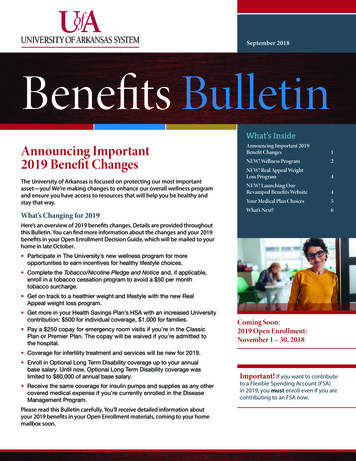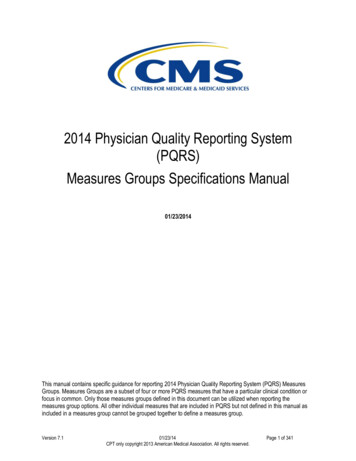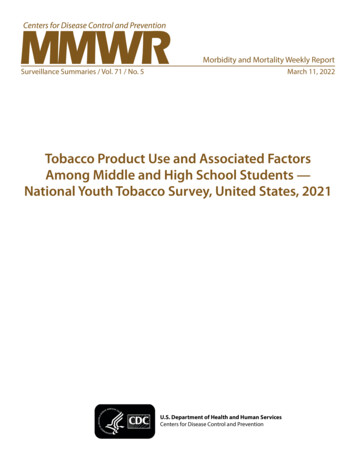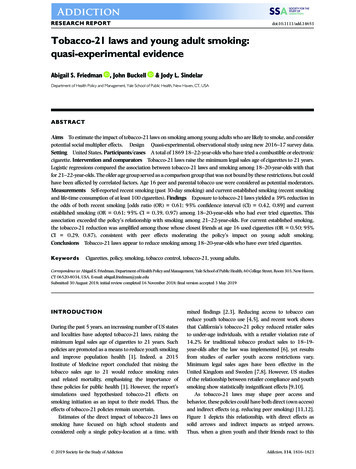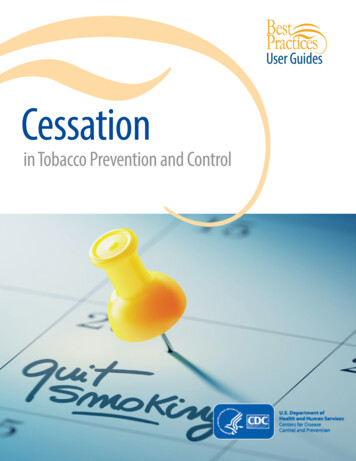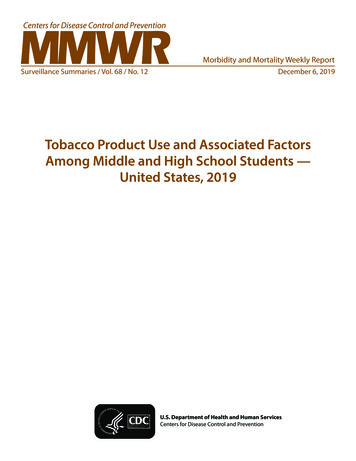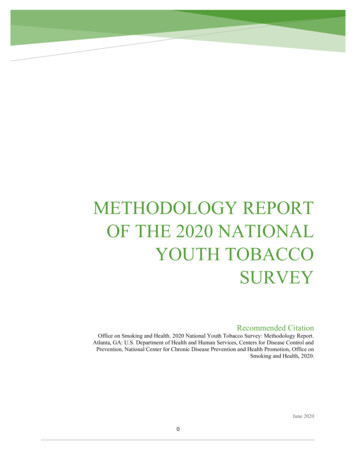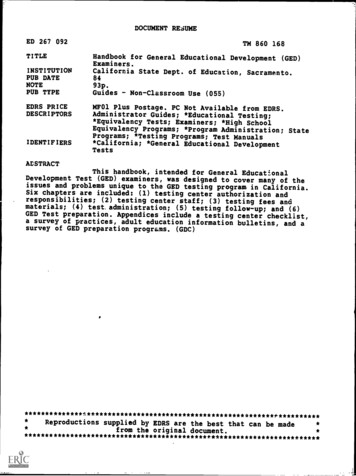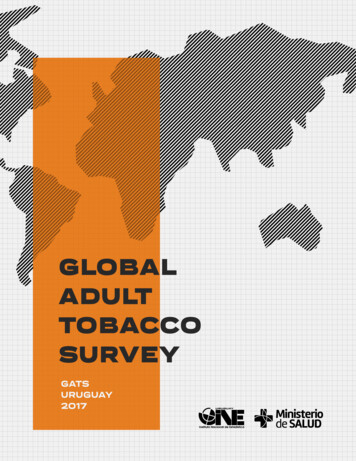
Transcription
GLOBALADULTTOBACCOSURVEYGATSURUGUAY2017
2
GATS URUGUAY TEAMMINISTRY OFPUBLIC HEALTH (MSP)NATIONAL STATISTICSINSTITUTE (INE)General Coordinator for MSPAna LorenzoGeneral Coordinator for INELeonardo CuelloProgram in charge of General CoordinationNational Tobacco Control Program (PNCT)Ministry of Public HealthDepartment in chargeSociodemographic StudiesDirector of PNCTEnrique SotoMedical School University of the RepublicMary BarrosHonorary Commission to Combat CancerAmanda SicaNational Resources FundElba EstevesUruguayan Tobaccology Society (SUT)Beatriz GojaDepartment headAndrea MacariDivision DirectorCarlos CalvoDivision SubdirectorAdriana VernengoSampling design and weightingJuan Pablo FerreiraIT TeamGerónimo HoffmanDiego MasielloGeomaticsAna Inés LópezSurvey SpecialistStella BerrutiReview SpecialistHugo LagunaReviewersDaniel FloresFernanda DelgadoGonzalo PuigOriana HenigAdministration and FinanceKarina MaliNora Machado3
SUPERVISORSINTERVIEWERSNoela VenetCecilia MessinaAna BenavidesAndrea GonzálezAnne MurganAntonella GattoBeatriz GándarasCamila MatussevicioCarmen BelénCinthia Da SilvaClara HernándezDinorah EstefanEliana GonzálezEstefanía CabreraEstela BarriosGabrielle VillanuevaGilda CuelloGiovana SuárezJacquelin SánchezKaren GalloLeandro MachadoLeticia ÁlvarezLidia CoronelLiliana ValenciaLourdes BerrospeLucía Baffigo4Malvina PintosMarcela AyalaMarcos ÁlvezÁngel CedrésMaría DomínguezMaría Eugenia CosoyMaría Eugenia DíazMariana BlancoMelisa PandolfiMiguel OjedaMildred SeveroMilene RoullierNadia Da LuzPablo CapurroPablo GallotaPaola SeveroRafael PossiRaúl RuizRosario CayetanoRosemary RutingSilvia GómezSofía IdiarteStella Cessa
ACKNOWLEDGEMENTSThe Global Adult Tobacco Survey (GATS) is part of the Global Tobacco Surveillance System.The Ministry of Public Health would like to thank the following international partnersand collaborators for their support in implementing GATS in Uruguay.INTERNATIONAL PARTNERSINTERNATIONAL COLLABORATORSThe Pan American Health Organization/World HealthOrganization (PAHO/WHO) provided technical andadministrative assistance during the various phases ofimplementation.PAHO/WHO Regional OfficeRoberta CaixetaAdriana Bacelar GomesThe Centers for Disease Control and Prevention (CDC) ofthe United States provided technical support, ensuringthe use of standardized protocols, as a result of whichkey indicators are comparable with those of other GATScountries.The Research Triangle Institute (RTI) provided thesoftware used for data collection, as well as technicalassistance on IT matters.Financial support for GATS Uruguay was provided byBloomberg Philanthropies, as part of the BloombergInitiative to Reduce Tobacco Use, and by the Ministry ofPublic Health of Uruguay.5PAHO/WHO Representative Office in UruguayMaría Griselda Bittar GonzálezRicardo Rodríguez-BuñoCenters for Disease Control and Prevention (CDC)Jeremy Morton, CDC Focal Point for GATS UruguayEdward Rainey, IT SpecialistSimone Salanday, StatisticsTenecia Smith, StatisticsKrishna Palipudi, GTSS Team LeaderIndu Ahluwalia, Global Tobacco Control Branch ChiefGATS Uruguay Technical CommitteeThe Ministry of Public Health wishes to acknowledgethe enormous commitment and experience of the GATSUruguay Technical Committee, whose dedication and hardwork made the entire GATS process possible and ensuredthe high quality of the survey.
PREFACEThe World Health Organization (WHO) has determined thatnoncommunicable diseases (NCDs) represent one of thegreatest challenges in this century, with great impact onthe health and quality of life of the world’s population.In planning health policies, tobacco control is one of thepreventive measures with the greatest impact on NCDs.There is abundant evidence of the benefits of giving upsmoking, both for individuals and their environment.The smoking epidemic is a global problem, with seriouspublic health consequences. It calls for the broadestpossible international cooperation and collaboration amongall countries, to join forces to meet the targets of the 2030Sustainable Development Goals (SDGs).As a result of this situation, WHO and World HealthAssembly decided to formulate the first internationalpublic health treaty, the WHO Framework Convention onTobacco Control (WHO FCTC).Uruguay ratified the WHO FCTC in September 2004, andin 2005 put in place a comprehensive set of measures, asmandated by the Convention.In 2009, the first Global Adult Tobacco Survey (GATS) wasconducted to evaluate the impact of the Convention’simplementation; results showed there were significantpositive health, environmental, and economic effects.that measures that have already been implemented bemaintained and strengthened.The second GATS survey was conducted in 2017 toassess progress on the priority concerns highlighted inthe initial survey. Between the first and second survey,bans were put in place on all advertising, promotion, andsponsorship of tobacco products, taxes on tobacco wereraised, the Protocol to Eliminate Illicit Trade in Tobaccowas ratified, and the relevant regulatory mechanismswere strengthened. As a result of these efforts, GATS 2017showed a continuing decline in the prevalence of tobaccoconsumption, along with a substantial improvement insome of the priority areas highlighted in 2009.Lastly, the cultural changes achieved in the wake of thetobacco control policy provide support for maintainingthese positive outcomes. Specifically, smoking is no longerconsidered socially acceptable.In presenting these findings, we wish to express ourappreciation to the people and institutions that have madethis research possible. We are confident that worldwideprogress on implementing the WHO FCTC will speed effortsto achieve a healthier world, with greater equity for all of itsinhabitants.The WHO FCTC is an effective tool for curbing the smokingepidemic and counteracting the serious consequences oftobacco use, and it has proved to be a cost-effective andaccessible strategy for any country, regardless of incomelevel.Tobacco control strategies are central to Uruguay’s healthpolicies. In addition to implementing nearly all of themain measures of the Framework Convention, it is vitalDr. Jorge BassoMinister of Public Health6
CONTENIDOSEXECUTIVE SUMMARY1. INTRODUCTION.12. . . . . . . . . . . . . . . . . . . . . . . . . . . . . . . . 171.1. Tobacco control policies in Uruguay . . . . . . . . . . . . . . . . . . . . . . . . . . . . . . . . 191.1.1. Monitoring the use of tobacco and prevention policies . . . . . . . . . . . . . . . . . . . . . . . . . 201.1.1.1. Tobacco use in adults . . . . . . . . . . . . . . . . . . . . . . . . . . . . . . . . 201.1.1.2. Tobacco use in young people. . . . . . . . . . . . . . . . . . . . . . . . . . . . . 201.1.1.3. Mortality attributable to tobacco use. 201.1.1.4. Research on tobacco-smoke air pollution . 201.1.1.5. Economic studies . . . . . . . . . . . . . . . . . . . . . . . . . . . . . . . . . 201.1.2. Protecting people from exposure to tobacco smoke. 211.1.3. Offering help for quitting tobacco use . . . . . . . . . . . . . . . . . . . . . . . . . . . . . 211.1.4. Warning about the dangers of tobacco .1.1.5. Enforcing bans on tobacco advertising, promotion, and sponsorship .1.1.6. Raising taxes on tobacco .2. OBJECTIVES. 22. 23.23.253. METHODOLOGY.293.1. GATS Technical Committee.3.2. Design of the questionnaire . 30.303.3. Sampling design . . . . . . . . . . . . . . . . . . . . . . . . . . . . . . . . . . . . . . 303.3.1. Eligibility.3.3.2. Sampling design .3.3.2.1. Stratification .30. 30. 303.3.2.2. Selection of the sample .313.3.2.3. Sample size . 31.3.3.2.4. Rate of response for households and individuals. 323.3.3. Weighting. 33.3.3.3.1. Determination of the original weighting factors . . . . . . . . . . . . . . . . . . . . . . 333.3.3.2. Adjustment for unknown eligibility .3.3.3.3. Adjustment for non-response.3.3.3.4. Determination of the weighting factors for individuals (interviewees) .3.3.3.5. Adjustment for non-response of individuals3.3.3.6. Calibration of the weighting factors. 33. 34. 35. . . . . . . . . . . . . . . . . . . . . . . 36. 373.3.3.7. Variability of the final weighting factors . . . . . . . . . . . . . . . . . . . . . . . . . 383.4. INE work team.393.5. Pilot phase.393.6. Field work.403.6.1. Recruitment of interviewers . . . . . . . . . . . . . . . . . . . . . . . . . . . . . . . . 403.6.2. Features of the training. . . . . . . . . . . . . . . . . . . . . . . . . . . . . . . . . 403.6.3. Type of interview and respondent . . . . . . . . . . . . . . . . . . . . . . . . . . . . . . 403.6.4. Field wok .403.6.5. Field work results.413.7. Validation of the information . 413.7.1. Review of the database . . . . . . . . . . . . . . . . . . . . . . . . . . . . . . . . . . 413.7.2. Telephone oversight . . . . . . . . . . . . . . . . . . . . . . . . . . . . . . . . . . . 413.7.3. Clean-up and completion of the database . . . . . . . . . . . . . . . . . . . . . . . . . . . 417
4. RESULTS4.1. Tobacco use.4.1.1. Prevalence of use .43.44. 444.1.2. Type of product . . . . . . . . . . . . . . . . . . . . . . . . . . . . . . . . . . . . 464.1.3. Intensity of consumption . . . . . . . . . . . . . . . . . . . . . . . . . . . . . . . . . 474.1.4. Age at which smoking began . 474.1.5. Indicator of dependence . . . . . . . . . . . . . . . . . . . . . . . . . . . . . . . . . 474.1.6. Electronic cigarettes .49.504.2.1. Smoking cessation rate. 504.2.2. Health-team intervention. 514.2. Cessation.4.2.3. Motivation . . . . . . . . . . . . . . . . . . . . . . . . . . . . . . . . . . . . . . 524.3. Exposure to tobacco smoke. . . . . . . . . . . . . . . . . . . . . . . . . . . . . . . . . . 534.3.1. Workplace exposure . . . . . . . . . . . . . . . . . . . . . . . . . . . . . . . . . . . 534.3.2. Exposure to smoke in indoor public spaces . 544.3.3. Exposure in the home . . . . . . . . . . . . . . . . . . . . . . . . . . . . . . . . . . 554.4. Economics.4.4.1. Place of purchase .55. 554.4.2. Prices of tobacco products . . . . . . . . . . . . . . . . . . . . . . . . . . . . . . . . 564.5. The media.4.5.1. Antismoking information4.5.2. Health warnings.4.5.3. Tobacco advertising .4.6. Knowledge, attitudes, and perceptions .4.6.1. Knowledge about the health consequences of tobacco use.57. 57. 57. 58. 59.594.6.2. Knowledge about the health consequences of exposure to environmental tobacco smoke. 604.6.3. Knowledge about the health risk involved in light, ultralight, and mentholated cigarettes . . . . . . . . . . . 604.6.4. Addictiveness .5. COMPARATIVE FINDINGS: 2009-2017. 61.635.1. Tobacco use.645.2. Cessation.665.3. Exposure to tobacco smoke. . . . . . . . . . . . . . . . . . . . . . . . . . . . . . . . . . 685.4. Economics.5.5. The media.695.6. Knowledge, attitudes, and perceptions . 696. DISCUSSION69.716.1. Tobacco use.726.2. Cessation.6.3. Exposure to environmental tobacco smoke .74. 757. CONCLUSIONS AND RECOMMENDATIONS.8.73. 74.6.6. Knowledge, attitudes, and perceptions .6.5. The media.6.4. Economics8. ANNEXES.74.7783
INDEX OF FIGURESAND TABLESINDEX OF FIGURESFigure 1: Distribution of the adjustments for unknown eligibilityFigure 2: Distribution of weighting factors adjusted for unknown eligibilityFigure 3: Distribution of adjustments for households with unknown eligibilityFigure 4: Weighting factors d1 with respect to weighting factors d2Figure 5: Distribution of calibration adjustment factors (g)Figure 6: Weighting factors adjusted for non-responseFigure 7: Prevalence of tobacco use by type of consumption and sexFigure 8: Smoking of hand-rolled cigarettes, by sex and educational levelFigure 9: Distribution of daily smokers, by sex, according to the amount of time between waking and lighting the first cigaretteFigure 10: Tobacco use according to Index of Socioeconomic Level (INSE)Figure 11: Tobacco use according to Index of Socioeconomic Level (INSE), by place of residenceFigure 12: Distribution of current smokers (15 years of age and older) according to interest in quittingFigure 13: Place where last cigarette purchase was madeFigure 14: Average monthly spending on manufactured cigarettes, by educational levelFigure 15: Percentage of people who saw antismoking information in the last 30 days, by communications mediumFigure 16: Percentage of smokers who thought about quitting smoking due to health warnings, by educational levelFigure 17: Percentage of people who believed that smoking causes serious illnessFigure 18: Percentage of people, by age, who do not know that mentholated, light, and ultralight cigarettes are as harmful as commoncigarettesFigure 18b: Percentage of people, by educational level, who do not know that mentholated, light, ultralight, and mild cigarettes are asharmful as regular cigarettesFigure 19: 2009-2017 comparison. Prevalence of tobacco use, by sexFigure 20: 2009-2017 comparison. Prevalence of tobacco use, by ageFigure 21: 2009-2017 comparison. Attempt to quit in the last year, by ageFigure 22: 2009-2017 comparison. Among people who visited health facilities in the year prior to the survey, those who received healthteam interventionsFigure 23: 2009-2017 comparison. Exposure to environmental tobacco smoke in various public spacesFigure 24: 2009-2017 comparison. Proportion of households with smokers9
INDEX OF TABLESTable 1. Distribution of sample sizes for each stratumTable 2. Final status of selected households and individuals in the sample, by place of residence (without weighting)Table 3. Table 3: Summary statistics for wij weights segmented by design stratumTable 4: Weighted response rates and adjustments for each classTable 5. Final status of each caseTable 6. Distribution of people by sex, according to tobacco useTable 7a. Distribution of daily smokers by sex, according to ageTable 7b. Distribution of occasional smokers by sex, according to ageTable 7c. Distribution of non-smokers by sex, according to ageTable 8. Distribution of non-smokers by sex, according to type of previous useTable 9. Prevalence, by sex, of different tobacco products used by current smokersTable 10. Use of electronic cigarettes by age and educational levelTable 11. Cessation rate by sex and educational levelTable 12. Percentage of smokers, by sex, who attempted to quit, and who received medical advice on quittingTable 13. Percentage of people exposed to tobacco smoke at work within the general population and among non-smokers, by sex and ageTable 14. Percentage of people exposed to tobacco smoke in public spaces in the last 30 days, according tosociodemographic characteristicsTable 15. Percentage of people exposed to tobacco smoke in the home, according to sex and age groupsTable 16. Percentage of people who saw advertising for tobacco products, according to demographic characteristicsTable 17. 2009-2017 comparison. Prevalence of tobacco use by educational level.Table 18. 2009-2017 comparison. Prevalence of daily smokers, occasional smokers, and non-smokers, by age groupTable 19. 2009-2017 comparison. Cessation rate by sex and educational levelCHART:Chat 1: Organizational chart of the INE work team10
EXECUTIVESUMMARYINTRODUCTIONMETHODOLOGYIn September 2004, Uruguay ratified the World HealthOrganization (WHO) Framework Convention on TobaccoControl (WHO FCTC). In March 2005, the National TobaccoControl Program was created, under the aegis of the Ministryof Public Health and, nearly simultaneously, a set of measureswas implemented, consistent with the recommendations inthe WHO FCTC.GATS is a representative national-level survey that pollspeople 15 years of age and older. It randomly selects onemember of each household in the sample to participatein the survey. Between November 2016 and February 2017,Uruguay’s 19 departments (provinces) were visited. Thesample comprised a total of 6,240 households; 4,966interviews were conducted, with an overall response rate of89.4%.Article 20.2 of the WHO FCTC states the need for systematicmonitoring of tobacco use, in a way that ensures thecomparability of country results. Consistent with thismandate, Uruguay in 2016 repeated the Global Adult TobaccoSurvey (GATS), first conducted in 2009. GATS was developedby the Centers for Disease Control and Prevention (CDC), inAtlanta, and WHO, as part of the World Tobacco SurveillanceSystem (GTSS).The second Uruguay GATS made it possible to measurechanges in tobacco use, and to analyze the impact ofmeasures to control tobacco use, particularly in areashighlighted by the findings of the 2009 survey.GATS is a representative national-level survey conductedamong people 15 years of age and older. Using a standardizedquestionnaire, it assesses the prevalence of tobacco use,while employing key indicators to evaluate the principalmeasures contained in the FCTC.As in 2009, the Ministry of Public Health selected the NationalStatistics Institute (INE) to oversee implementation of GATSin Uruguay.11As in 2009, GATS obtained information on the prevalenceof tobacco use, exposure to environmental tobacco smoke,knowledge and attitudes about tobacco, cessation of use,economic implications, and exposure to advertising, inaddition to key sociodemographic characteristics of thepeople surveyed.
FINDINGSTobacco useIn 2017, 21.6% of those surveyed (25.6% of men and 18.0% ofwomen) reported that they currently smoked some formof tobacco. The prevalence of current tobacco use in adultswas 22.9% in Montevideo and 20.7% in the rest of the country.Overall, 18.3% (21.5% of men and 15.3% of women) currentlysmoked on a daily basis.Broken down by age group, the prevalence of current tobaccouse was 14.6% in the 15- to 24-year-old population, 29.0% inthe 25-44 age group, 26.0% in the 45-64 age group, and 9.0%among people 65 years of age and older.Disaggregated by educational level,11 the prevalence ofcurrent consumption was 24.1% among people with a gradeschool education, 27.1% among those who had completedsecondary basic, 23.6% among those who had completedsecondary school, and 14.2% among those with a tertiaryeducation.Cigarettes were the main form of tobacco smoked (totalprevalence 21.4%), including manufactured cigarettes (18.4%)and hand-rolled cigarettes (5.9%).Overall, daily smokers smoked an average of 15.2 cigarettesper day (men 16.7 and women 13.4). Among those who hadalways smoked daily, the average age at which daily cigarettesmoking began was 16.3 years (16.3 years for men and 16.2 forwomen). Among those who always smoked on a daily basis,the proportion who had quit was 45.7% (48.1% of men and42.3% of women).Cessation of tobacco useIn 2017, 45.9% of those who had smoked in the previous 12months tried to quit. In all, 78.6% of smokers2 who had visiteda health provider in the previous 12 months had been askedwhether they smoked, 52.0% were advised to quit, and 18.2%received guidance or support to do so. Of current smokerswho attempted to quit during the previous 12 months andformer smokers who had quit less than 12 months before,91.2% made the attempt without any type of assistance.Of current smokers, 10.3% were planning to or thinking aboutquitting in the next month, 22.4% were thinking of quittingin the next 12 months, and 40.2% were expecting to quitsmoking at some future time, but not in the next 12 months.Exposure to environmental tobacco smokeAccording to the survey, 11.1% of adults were exposed totobacco smoke at work in enclosed areas during the previous30 days. By educational level, 16.1% of those with primaryschool education, 15.9% with secondary basic education,6.8% with secondary education, and 4.3% with tertiaryeducation were exposed to tobacco smoke at work.Overall, 20.0% were exposed to tobacco smoke in thehome at least once a week. By educational level, amongthose experiencing such exposure, 22.3% of respondentshad primary education, 16.9% had completed secondaryeducation, 16.7% had secondary basic education, and 12.7%had tertiary education.Among people who had visited public areas during theprevious 30 days, 19.5% were exposed to environmentaltobacco smoke in bars, pubs, or discotheques, 11.3% incolleges or universities, 6.1% in public transportationenvironments; 6.0% in schools; 2.9% in government buildings;2.8% in restaurants; and 2.2% at health care facilities.Tobacco economicsAmong cigarette smokers, average monthly spending onmanufactured cigarettes was 1,849.80 Uruguayan pesos( 2,053.50 for men and 1,621.70 for women).More than half of all smokers of manufactured cigarettes(56.0%) purchased their cigarettes at stores. cenes.Advertising, promotion, and sponsorshipIn total, 16.8% of adults had seen cigarette advertising instores where cigarettes are sold (18.5% of men and 15.4% ofwomen). By age group, the figures were 29.9% in the 15- to24-year-old age group, 16.9% in the 25-44 age group, 13.0% inthe 45-64 age group, and 8.2% in the group 65 years of ageand older.In the previous 30 days, 34.5% of respondents had seen someform of cigarette advertising, promotion, or sponsorship.1 Educational level was reported only for respondents 25 years of age and older2 Among current and former smokers who had been abstaining for less than 12 months.12
By age group, the figures were 49.5% in the 15- to 24-year-oldage group, 34.8% in the 25-44 age group, 30.9% in the 45-64age group, and 22.9% in the 65-year-old and older age group.Among current smokers, 95.7% had seen health warnings oncigarette packages; 42.9% had thought about quitting as aresult of the warnings on packages.Knowledge, attitudes, and perceptionsAccording to the survey, 97.5% of people believed thatsmoking causes serious illness. Those who believed it causesvarious illnesses cited the following: lung cancer (97.8%),heart attack (91.5%), low birthweight (83.3%), prematurebirth (81.2%), stroke (76.5%), and bladder cancer (36.3%).Similarly, 92.4% of the respondents (90.6% of smokersand 92.9% of non-smokers) believed that breathing otherpeople’s smoke causes serious illness in non-smokers.Among those who believed that smoking causes seriousillness, 21.2% did not know that light, ultralight, mild, andmentholated cigarettes are as detrimental to health asregular cigarettes.Sixty-four-point-two percent (62.4%) of adults believedthat smokeless tobacco causes serious illness, while 43.4%believed that electronic cigarettes are less dangerous tohealth than normal cigarettes.GATS FROM 2009 TO 2017Tobacco use declined significantly among men during thisperiod: from 30.7% in 2009 to 25.6% in 2017. Among women,19.8% reported current tobacco use in 2009 versus 18.0% in2017 – not a statistically significant difference.The greatest reduction in the prevalence of tobacco usewas seen in 15- to 24-year-olds, where it fell from 24.7% to14.6%, representing a 40.9% decline. By educational level, thegreatest decline (33.4%) was seen in the population with atertiary education (21.3% in 2009 versus 14.2% in 2017).Among daily smokers, the average number of cigarettessmoked daily declined among the 15- to 24-year-old agegroup, from 13.3 in 2009 to 10.5 in 2017 (a decline of 21.4%),while among the population with a tertiary education thisnumber dropped from 14.5 in 2009 to 11.6 in 2017 (a declineof 19.8%).By type of cigarette smoked, the greatest decline was inhand-rolled cigarettes (from 8.1% in 2009 to 5.9% in 2017),representing a decline of 27.2%.Exposure to environmental tobacco smoke (ETS) in homes,workplaces, and public places fell significantly between2009 and 2017. In homes, exposure to ETS (on a weekly, ormore frequent, basis) fell from 29.2% to 20.0%, a decline of31.5%. In the workplace (in the 30 days prior to the responsedate), exposure to ETS fell from 16.5% to 11.1%, a decline of32.8%. The greatest drop in exposure to ETS in public places(in the 30 days prior to the response date) occurred incolleges and universities, where it fell from 27.5% to 11.3%, a58.8% decrease.The proportion of smokers who were asked by health careworkers whether they smoked, were advised to quit, orreported that they had received guidance to quit fromhealth workers, remained unchanged between 2009 and2017.The percentage of current smokers who noticed healthwarnings on cigarette packages or considered quittingas a result of those health warnings remained unchangedbetween 2009 and 2017. The only significant change amongcurrent smokers who considered quitting as a result ofthe health warnings occurred in the 15-to-24 age group,where the figure fell from 53.2% in 2009 to 38.3% in 2017,representing a decline of 28.0%.13
There was a significant reduction in the percentage of adultswho reported seeing some form of tobacco advertising,sponsorship, or promotion in the previous 30 days: from44.3% in 2009 to 34.5% in 2017, a decline of 22.1%. Although theviewing of tobacco advertising, sponsorship, and promotiondiminished in all age groups, the smallest reduction (19.1%)occurred in the 15-to-24 age group.The percentage of people who saw cigarette advertising inbusinesses fell from 20.9% in 2009 to 16.8% in 2017, a declineof 19.4%.Among current smokers of manufactured cigarettes,the average cost of a pack of 20 cigarettes remainedapproximately the same as the 2009 price ( 106.10 inflationadjusted Uruguayan pesos in 2009 to 105.00 Uruguayanpesos in 2017). Average monthly spending on cigarettes alsoshowed no significant change ( 1740.1 inflation-adjustedUruguayan pesos in 2009, 1849.8 Uruguayan pesos in 2017).The percentage of adults who did not know that light,ultralight, mild, and mentholated cigarettes are asdetrimental as regular cigarettes dropped from 24.7% in2009 to 21.2% in 2017, a decline of 14.3%.CONCLUSIONSAfter Uruguay ratified the WHO FCTC in 2004, acomprehensive set of tobacco control measures wasimplemented. This included smoke-free environmentswithout exception, health warnings covering 80% of thetwo main faces of cigarette packages, the requirementthat each brand have a standardized format, a broad banon tobacco advertising, promotion, and sponsorship, alongwith treatment for tobacco dependence at all health carefacilities.In the period between the two GATS surveys, additionalmeasures were implemented in the country, including thetotal prohibition of tobacco advertising, promotion, andsponsorship (with elimination of the previous point-of-saleexception), a prohibition on exhibiting tobacco productsat points of sale, ratification of the WHO FCTC Protocolto Eliminate Il
The WHO FCTC is an effective tool for curbing the smoking epidemic and counteracting the serious consequences of tobacco use, and it has proved to be a cost-effective and accessible strategy for any country, regardless of income level. Tobacco control strategies are central to Uruguay's health policies.
